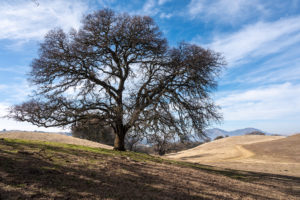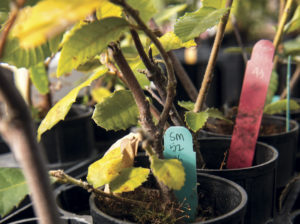By the time that sudden oak death (SOD) began hitting North Bay oaks and tanoaks in the mid-1990s, Ted Swiecki and Elizabeth Bernhardt, husband-and-wife plant pathologists, had been studying oak diseases in California oak woodlands for many years in the inner Coast Ranges and Sierra foothills. Shifting focus to Marin and Sonoma counties, Swiecki and Bernhardt began to work with vulnerable oaks and tanoaks, including stands that the Kashaya Band of Pomo Indians harvest for acorns.
BN: How did you get involved in research on sudden oak death?
TS: Nobody had really done much study of oaks—either their diseases or the impact of insects—because, unlike conifers, they’re not commercial species in California. So there wasn’t any real money to pay for research. Much of our initial work was related to the lack of regeneration of blue and valley oaks, so we were primarily studying oaks in the foothills that surround the Central Valley. It was generally thought that coast live oak was in good shape with respect to regeneration.
When they started to detect this unusual mortality in oaks in the Bay Area, we set up some research plots to help figure out what was going on. That was about the time that Dave Rizzo at UC Davis had isolated the pathogen organism. So in the summer of 2000 we were in at the ground level when the disease was identified.
BN: If oaks aren’t commercially important, what drove the new research?
TS: If you have these trees dying, the fire danger is phenomenal. Oaks are a major component of the mixed hardwood community. Initially, it was the aesthetics and property values, but as the number of dead trees grew, fire risk became one of the major issues.
BN: How did you connect with the Kashaya Band of Pomo Indians?
TS: Susan Frankel of the U.S. Forest Service contacted us after getting in touch with tribal members over the issue. The impact of SOD for them goes to the core of their cultural history. Acorns from tanoak are a big food staple and an anchor in maintaining their traditional life ways. Kashaya families collect acorns from the same group of trees, traditionally over generations. You don’t say, “This tree’s dead, we’ll go to another one.” It’s like losing a member of your family to lose one of these trees.
The Kashaya have a small 40-acre rancheria, at Stewart’s Point in Sonoma County, and the disease is working its way toward them. Their acorn collection area extends beyond the rancheria and covers a big chunk of northwestern Sonoma County. You can see thousands and thousands of dead trees in some places there that, three or four years ago, looked okay.
BN: Has working with the tribe impacted your own work?
TS: It has affected the type of research we’re doing. We’re always interested in overall ecosystem function, and the human dimension makes for a more complete ecosystem—people interacting with the forest. We had to see how the treatments on the trees would affect the acorns. One of the only viable SOD control methods is potassium phosphite, which is a pretty innocuous material, an inorganic salt.
If we were just looking for disease control, we wouldn’t worry about the acorns at all, as long as the plants continue to germinate after treatment. But you’re talking about acorns for consumption by the native tribes, about a culturally important food source. So saying “this is safe” isn’t going to cut it. If I was in their position, I wouldn’t take things at face value either. We have to find out if phosphite changes the acorns. So part of the study is a cooperative project with the food science department at UC Davis. There’s an outside chance phosphite could affect the balance of tannins or otherwise affect acorn quality. If it does, this material may not be acceptable for use on trees whose acorns are being harvested for food, even if it controls the disease.
There are only little bits of scientific knowledge about white oak acorns, and there’s practically nothing about tanoak acorns. We don’t know how much they might vary from tree to tree, or from year to year. So in the analysis, you have to be able to adjust for all these possibilities. They may differ, but we have to be sure that the difference is due to what we apply and not just due to “It’s a wetter year this year,” “It’s a hotter year than last year.” And trees right next to each other can produce acorns with different properties. When you try to scientifically document what’s going on, it becomes a very complex system.

.jpg)



